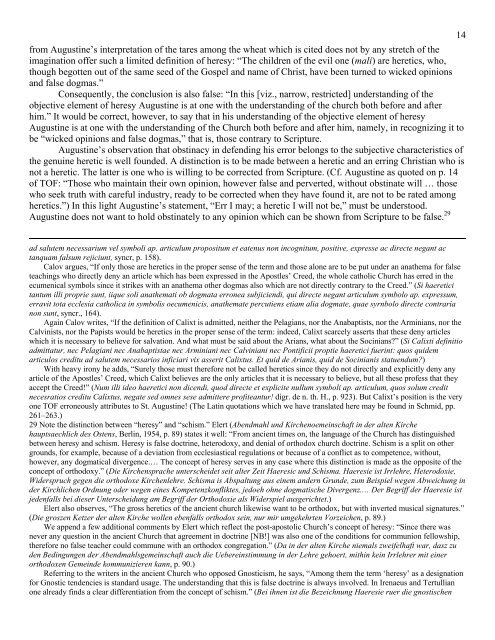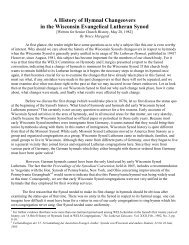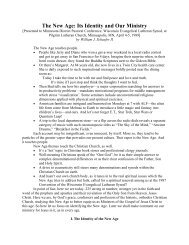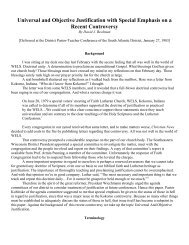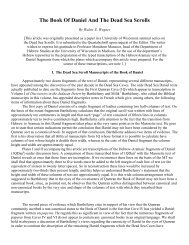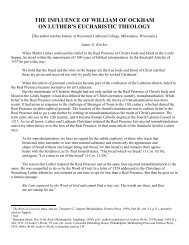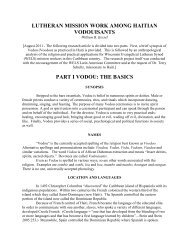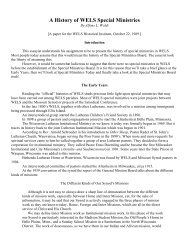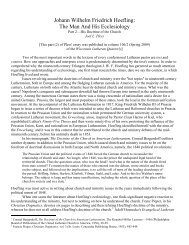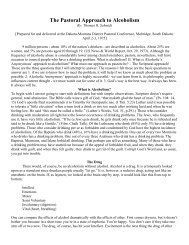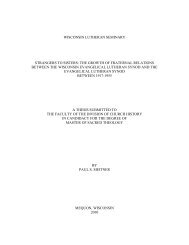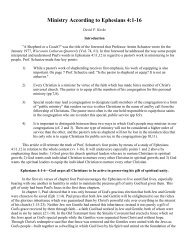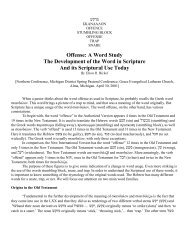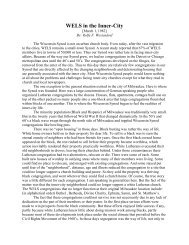What Is Heresy? - Wisconsin Lutheran Seminary Library: Essays
What Is Heresy? - Wisconsin Lutheran Seminary Library: Essays
What Is Heresy? - Wisconsin Lutheran Seminary Library: Essays
You also want an ePaper? Increase the reach of your titles
YUMPU automatically turns print PDFs into web optimized ePapers that Google loves.
14<br />
from Augustine’s interpretation of the tares among the wheat which is cited does not by any stretch of the<br />
imagination offer such a limited definition of heresy: “The children of the evil one (mali) are heretics, who,<br />
though begotten out of the same seed of the Gospel and name of Christ, have been turned to wicked opinions<br />
and false dogmas.”<br />
Consequently, the conclusion is also false: “In this [viz., narrow, restricted] understanding of the<br />
objective element of heresy Augustine is at one with the understanding of the church both before and after<br />
him.” It would be correct, however, to say that in his understanding of the objective element of heresy<br />
Augustine is at one with the understanding of the Church both before and after him, namely, in recognizing it to<br />
be “wicked opinions and false dogmas,” that is, those contrary to Scripture.<br />
Augustine’s observation that obstinacy in defending his error belongs to the subjective characteristics of<br />
the genuine heretic is well founded. A distinction is to be made between a heretic and an erring Christian who is<br />
not a heretic. The latter is one who is willing to be corrected from Scripture. (Cf. Augustine as quoted on p. 14<br />
of TOF: “Those who maintain their own opinion, however false and perverted, without obstinate will … those<br />
who seek truth with careful industry, ready to be corrected when they have found it, are not to be rated among<br />
heretics.”) In this light Augustine’s statement, “Err I may; a heretic I will not be,” must be understood.<br />
Augustine does not want to hold obstinately to any opinion which can be shown from Scripture to be false. 29<br />
ad salutem necessarium vel symboli ap. articulum propositum et eatenus non incognitum, positive, expresse ac directe negant ac<br />
tanquam falsum rejiciunt, syncr, p. 158).<br />
Calov argues, “If only those are heretics in the proper sense of the term and those alone are to be put under an anathema for false<br />
teachings who directly deny an article which has been expressed in the Apostles’ Creed, the whole catholic Church has erred in the<br />
ecumenical symbols since it strikes with an anathema other dogmas also which are not directly contrary to the Creed.” (Si haeretici<br />
tantum illi proprie sunt, iique soli anathemati ob dogmata erronea subjiciendi, qui directe negant articulum symbolo ap. expressum,<br />
erravit tota ecclesia catholica in symbolis oecumenicis, anathemate percutiens etiam alia dogmate, quae syrnbolo directe contraria<br />
non sunt, syncr., 164).<br />
Again Calov writes, “If the definition of Calixt is admitted, neither the Pelagians, nor the Anabaptists, nor the Arminians, nor the<br />
Calvinists, nor the Papists would be heretics in the proper sense of the term: indeed, Calixt scarcely asserts that these deny articles<br />
which it is necessary to believe for salvation. And what must be said about the Arians, what about the Socinians?” (Si Calixti definitio<br />
admittatur, nec Pelagiani nec Anabaptistae nec Arminiani nec Calviniani nec Pontificii proptie haeretici fuerint: quos quidem<br />
articulos creditu ad salutem necessarios inficiari vix asserit Calixtus. Et quid de Arianis, quid de Socinianis statuendum?)<br />
With heavy irony he adds, “Surely those must therefore not be called heretics since they do not directly and explicitly deny any<br />
article of the Apostles’ Creed, which Calixt believes are the only articles that it is necessary to believe, but all these profess that they<br />
accept the Creed!” (Num illi ideo haeretici non dicendi, quod directe et explicite nullum symboli ap. articulum, quos solum credit<br />
necesratios creditu Calixtus, negate sed omnes sese admittere profiteantur! digr. de n. th. H., p. 923). But Calixt’s position is the very<br />
one TOF erroneously attributes to St. Augustine! (The Latin quotations which we have translated here may be found in Schmid, pp.<br />
261–263.)<br />
29 Note the distinction between “heresy” and “schism.” Elert (Abendmahl und Kirchenoemeinschaft in der alten Kirche<br />
hauptsaechlich des Ostens, Berlin, 1954, p. 89) states it well: “From ancient times on, the language of the Church has distinguished<br />
between heresy and schism. <strong>Heresy</strong> is false doctrine, heterodoxy, and denial of orthodox church doctrine. Schism is a split on other<br />
grounds, for example, because of a deviation from ecclesiastical regulations or because of a conflict as to competence, without,<br />
however, any dogmatical divergence.… The concept of heresy serves in any case where this distinction is made as the opposite of the<br />
concept of orthodoxy.” (Die Kirchensprache unterscheidet seit alter Zeit Haeresic und Schisma. Haeresie ist Irrlehre, Heterodoxie,<br />
Widerspruch gegen die orthodoxe Kirchenlehre. Schisma is Abspaltung aus einem andern Grunde, zum Beispiel wegen Abweichung in<br />
der Kirchlichen Ordnung oder wegen eines Kompetenzkonfliktes, jedoeh ohne dogmatische Divergenz.… Der Begriff der Haeresie ist<br />
jedenfalls bei dieser Unterscheidung am Begriff der Orthodoxie als Widerspiel ausgerichtet.)<br />
Elert also observes, “The gross heretics of the ancient church likewise want to be orthodox, but with inverted musical signatures.”<br />
(Die groszen Ketzer der alten Kirche wollen ebenfalls orthodox sein, nur mir umgekehrten Vorzeichen, p. 89.)<br />
We append a few additional comments by Elert which reflect the post-apostolic Church’s concept of heresy: “Since there was<br />
never any question in the ancient Church that agreement in doctrine [NB!] was also one of the conditions for communion fellowship,<br />
therefore no false teacher could commune with an orthodox congregation.” (Da in der alten Kirche niemals zweifelhaft war, dasz zu<br />
den Bedingungen der Abendmahlsgemeinschaft auch die Uebereinstimmung in der Lehre gehoert, mithin kein Irrlehrer mit einer<br />
orthodoxen Gemeinde kommunizieren kann, p. 90.)<br />
Referring to the writers in the ancient Church who opposed Gnosticism, he says, “Among them the term ‘heresy’ as a designation<br />
for Gnostic tendencies is standard usage. The understanding that this is false doctrine is always involved. In Irenaeus and Tertullian<br />
one already finds a clear differentiation from the concept of schism.” (Bei ihnen ist die Bezeichnung Haeresie ruer die gnostischen


